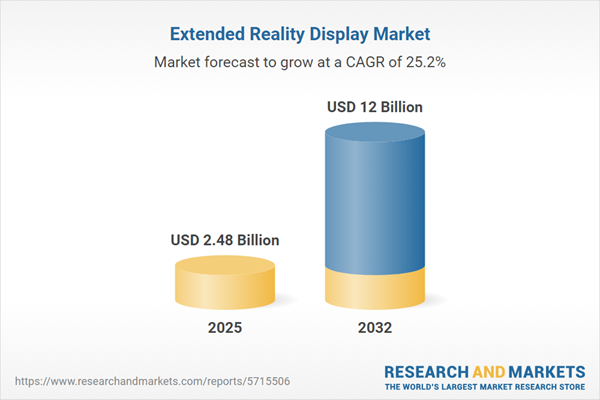Speak directly to the analyst to clarify any post sales queries you may have.
The global extended reality display market is reshaping enterprise innovation, providing senior decision-makers with essential tools for immersive collaboration and real-time operational adjustment. Rapid technology adoption is transforming how businesses visualize information, optimize workflows, and drive digital transformation initiatives at scale.
Market Snapshot: Global Extended Reality Display Market
The extended reality display market is expanding quickly, powered by significant investment and wider enterprise integration of immersive solutions. In 2024, the market is valued at USD 1.98 billion, with forecasts indicating growth to USD 2.48 billion by 2025 and an projected surge to USD 12 billion by 2032. This progression reflects a compound annual growth rate of 25.22%, supported by uptake across industries such as healthcare, automotive manufacturing, and entertainment. Technological progress in areas like miniaturized displays, advanced rendering, and seamless connectivity is encouraging broader adoption and prompting enterprises to revisit implementation strategies. Regulatory shifts and emerging technology trends further highlight the need for agile planning to safeguard competitive positioning.
Scope & Segmentation of the Extended Reality Display Market
Discerning the structure and segmentation of the extended reality display market enables leaders to align their technology investments with organizational objectives. Each segment supports domains where immersive displays are actively advancing collaboration, efficiency, and customer engagement across global industries.
- Connectivity Options: Solutions include DisplayPort, HDMI, USB-C, 5G, Bluetooth, and Wi-Fi to support deployment in offices, manufacturing floors, and distributed remote locations, allowing for flexible integration as requirements change.
- Device Types: Smartphone-based handhelds, tablets, standalone and tethered headsets, projection systems, and transparent interfaces serve a spectrum of applications ranging from operational support to immersive employee training.
- Display Technologies: LCD, LCoS, Micro-LED, and OLED technologies enable real-time diagnostics, collaborative task execution, and flexible command centers, aligning with diverse operational priorities.
- Technology Modes: Augmented, mixed, and virtual reality capabilities drive advancement in remote asset tracking, enhanced healthcare delivery systems, and multi-site project management.
- End Users: User segments include gaming, enterprise, automotive, healthcare, defense, retail, communications, and e-commerce sectors, ensuring solutions answer specific innovation and productivity needs.
- Regional Segmentation: Adoption is led by established infrastructure in the Americas and Europe, while Asia-Pacific and emerging markets register accelerated uptake in response to growing access and digital readiness.
- Company Profiles: Market leaders such as Meta Platforms, HTC, Sony Group Corporation, Lenovo, Samsung Electronics, Microsoft, Alphabet, Seiko Epson, LG Display, and BOE Technology Group steer technology evolution and supply chain resilience across the sector.
Key Takeaways for Senior Decision-Makers
- Micro-LED and OLED advancements ensure displays withstand business-critical demands for durability and visual clarity, supporting high-stakes operational goals.
- Next-generation connectivity, including 5G and updated Wi-Fi protocols, streamlines workflow and supports immediate data sharing among distributed and mobile teams, enhancing collaborative potential.
- Ergonomic and modular system designs reduce deployment challenges and expenses, empowering organizations to scale digital initiatives effectively, especially in complex enterprise environments.
- Convergence of hardware, software, and network providers produces adaptive digital ecosystems, supporting changing project needs across sectors and strengthening long-term planning.
- Strategic supply chain management mitigates global trade uncertainties, safeguarding consistent technology access and supporting uninterrupted business activity.
Tariff Impact on Market Structure and Sourcing
Recent modifications to U.S. tariff policies have increased costs for vital components like optical devices and display modules. As a response, enterprises relying on East and Southeast Asian suppliers now diversify sourcing approaches by building broader supplier bases and fostering regional partnerships. These strategies support resilience and sustained access to essential technology.
Methodology & Data Sources
This report is developed using a blend of insights gathered from senior executive interviews, third-party expert analysis, and thorough assessments of industry and academic publications. Evaluation of supply chain frameworks and robust data triangulation further assure the reliability of the conclusions provided.
Why This Report Matters
- Equips executives to drive well-informed investments and strategic planning tailored to their sector’s digital roadmap.
- Helps organizations anticipate and adapt to shifts in regulation and supply chain dynamics, enhancing operational resilience amidst an evolving market environment.
- Provides clear, practical strategies for leadership teams to leverage extended reality display technologies efficiently and at scale, attaining measurable impact.
Conclusion
Senior decision-makers can rely on this analysis to align technology initiatives with business strategy, maintain operational flexibility, and recognize new opportunities in a rapidly evolving enterprise landscape.
Additional Product Information:
- Purchase of this report includes 1 year online access with quarterly updates.
- This report can be updated on request. Please contact our Customer Experience team using the Ask a Question widget on our website.
Table of Contents
3. Executive Summary
4. Market Overview
7. Cumulative Impact of Artificial Intelligence 2025
Companies Mentioned
The companies profiled in this Extended Reality Display market report include:- Meta Platforms, Inc.
- Sony Group Corporation
- HTC Corporation
- Lenovo Group Limited
- Samsung Electronics Co., Ltd.
- Microsoft Corporation
- Alphabet Inc.
- Seiko Epson Corporation
- LG Display Co., Ltd.
- BOE Technology Group Co., Ltd.
Table Information
| Report Attribute | Details |
|---|---|
| No. of Pages | 195 |
| Published | October 2025 |
| Forecast Period | 2025 - 2032 |
| Estimated Market Value ( USD | $ 2.48 Billion |
| Forecasted Market Value ( USD | $ 12 Billion |
| Compound Annual Growth Rate | 25.2% |
| Regions Covered | Global |
| No. of Companies Mentioned | 11 |









